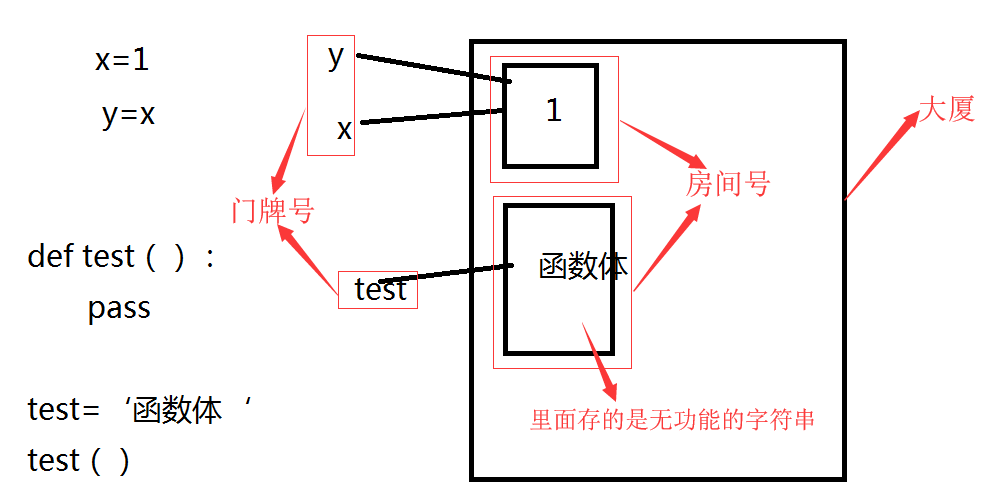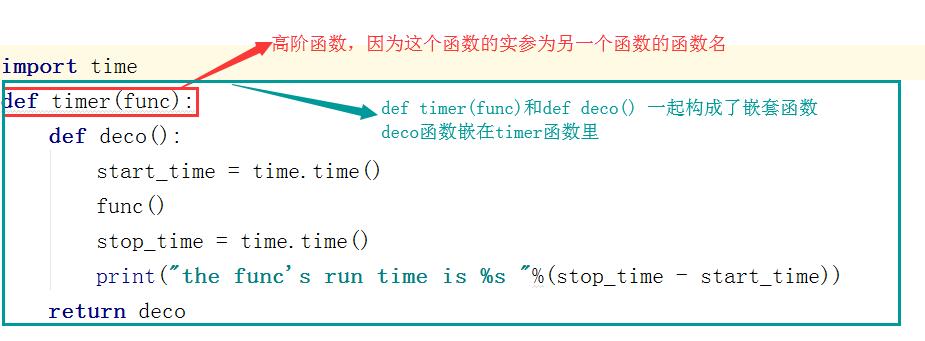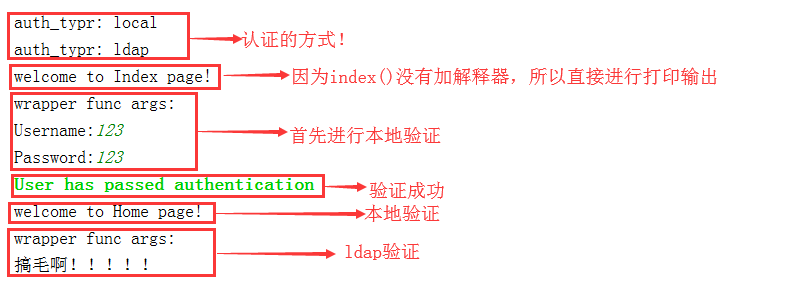大聊Python----装饰器
什么是装饰器?
装饰器其实和函数没啥区别,都是用def去定义的,其本质就是函数,而功能就是装饰其他的函数,说白了就是为其他函数提供附加功能
装饰器有什么作用?
比如你是一个公司的员工,你所写的程序里有100个函数,但是你所写的程序都已经上线运行了,突然有一天你的产品经理来找你,让你在咱们的APP上新增一段功能!那你说该怎么做这件事情?问题是你的程序都已经在运行了 ,不能修改你程序的源代码,否则会出现意想不到的效果!所以你想新增一项功能,但是不能修改你的源代码!那该怎么办呢?
装饰器对待被修饰的函数是完全透明的状态!也就是函数感觉不到装饰器的存在,装饰器没有动函数的源代码,也不影响函数的运行。
先看一下代码:
import time def timmer(func): # 装饰器
def warpper(*args,**kwargs):
start_time = time.time() # 开始的时间
func()
stop_time = time.time() # 结束的时间
print('the fun run time is %s'%(stop_time - start_time))
return warpper @timmer # 被装饰的函数
def test1():
time.sleep(3) # 延时3秒
print("in the test1") test1()
结果展示:

实现装饰器知识储备
1、函数即“变量”
机制:

函数调用顺序:其他高级语言类似,Python 不允许在函数未声明之前,对其进行引用或者调用
错误示范:
def foo():
print 'in the foo'
bar()
foo()
报错:
in the foo
Traceback (most recent call last):
File "<pyshell#13>", line 1, in <module>
foo()
File "<pyshell#12>", line 3, in foo
bar()
NameError: global name 'bar' is not defined
def foo():
print 'foo'
bar()
foo()
def bar():
print 'bar'
报错:NameError: global name 'bar' is not defined
正确示范:(注意,python为解释执行,函数foo在调用前已经声明了bar和foo,所以bar和foo无顺序之分)
def bar():
print 'in the bar'
def foo():
print 'in the foo'
bar()
foo()
def foo():
print 'in the foo'
bar()
def bar():
print 'in the bar'
foo()
2、高阶函数
a、就是把函数名当做实参传给另外一个函数(在不修改被装饰函数源代码的情况下为其增添功能)
示例:
import time def bar():
time.sleep(3)
print("in the bar")
def test1(func):
start_time = time.time()
func()
stop_time = time.time()
print("the func run rime is %s"%(stop_time - start_time)) test1(bar)
结果:

b、返回值中包含函数名(不修改函数的调用方式)
示例:
import time def bar():
time.sleep(3)
print("in the bar")
def test2(func):
print(func)
return func bar = test2(bar)
print(bar) # run bar
效果:
<function bar at 0x00000000007C48C8>
<function bar at 0x00000000007C48C8>
3、嵌套函数
局部作用域和全局作用域的访问顺序
x=0
def grandpa():
# x=1
def dad():
x=2
def son():
x=3
print(x)
son()
dad()
grandpa()
显示效果为:
3

高阶函数 + 嵌套函数 ==》 装饰器
先看个例子
import time
def timer(func):
def deco():
start_time = time.time()
func()
stop_time = time.time()
print("the func's run time is %s "%(stop_time - start_time))
return deco @timer
def test1():
time.sleep(3)
print("the test1 is running!") @timer
def test2():
time.sleep(3)
print("the test2 is running!") test1()
test2()

结果显示:
the test1 is running!
the func's run time is 3.000171422958374
the test2 is running!
the func's run time is 3.000171661376953
若想给test2传递参数,如下例,该怎么做呢?
import time
def timer(func):
def deco():
start_time = time.time()
func()
stop_time = time.time()
print("the func's run time is %s "%(stop_time - start_time))
return deco @timer
def test1():
time.sleep(3)
print("the test1 is running!") @timer
def test2(name):
time.sleep(3)
print("the test2 is running!",name) test1()
test2("alex")
通过执行,会出现下面的错误

意思是说,deco()缺少了一个元素!
那该怎么解决这个问题呢?
咱们先来捋顺下思路!
通过@timer可知test2() =timer(test2) = deco ,test2(name) = deco(name)
所以可以看出要给deco传递实参,所以做了下面
def timer(func):
def deco(name):
start_time = time.time()
func(name)
stop_time = time.time()
print("the func's run time is %s "%(stop_time - start_time))
return deco
通过执行,会看到下面的结果!

这回好了,test2不出错了,反而test1报错了,那个该怎么办呢?
看下test1出错的原因是test1的deco缺少了一个实参,那么问题来了,test1该怎么处理呢?
其实很简单,使用*args,和**kwargs尽可以完美的解决这个问题!
现在来看看经过改正的程序
import time
def timer(func):
def deco(*args,**kwargs):
start_time = time.time()
func(*args,**kwargs)
stop_time = time.time()
print("the func's run time is %s "%(stop_time - start_time))
return deco @timer
def test1():
time.sleep(3)
print("the test1 is running!") @timer
def test2(name):
time.sleep(3)
print("the test2 is running!",name) test1()
test2("alex")
结果显示:
the test1 is running!
the func's run time is 3.000171661376953
the test2 is running! alex
the func's run time is 3.000171422958374
装饰器之高潮
进入高潮之前,我们先来点前戏
先看下面的代码
import time
user , passwd = "sutaoyu" , "sutaoyu01" def auth(func):
def wrapper(*args,**kwargs):
username = input("Username").strip()
password = input("Password").strip()
if user == username and passwd == password:
print("\033[32;1mUser has passed authentication\033[0m")
func(*args,**kwargs)
else:
exit("\033[31;1mInvalid username and password\033[0m")
return wrapper @auth
def index():
print("welcome to index Page!") @auth
def home():
print("welcome to index Home!") @auth
def bbs():
print("welcome to index BBS!") index()
home()
bbs()
其输出的结果为:
输入正确时:

输入错误时:

现在当我们把前面的代码稍微改一下,装饰器代码不动,只改变下面两个地方
def index():
print("welcome to index Page!")
return "Page" print(index())
此时看输出的结果:

会发现无结果并为None,那是因为什么呢?
因为装饰器里的wrapper没有返回值所以,我们给他提供返回值即可!
def auth(func):
def wrapper(*args,**kwargs):
username = input("Username:").strip()
password = input("Password:").strip()
if user == username and passwd == password:
print("\033[32;1mUser has passed authentication\033[0m")
return func(*args,**kwargs)
else:
exit("\033[31;1mInvalid username and password\033[0m")
return wrapper
运行下程序,看看结果

可以看出,问题已经解决!
现在高潮部分即将来临:
我能不能让我的home在认证的时候用本地的认证,但是bbs认证的时候用远程的ldap?
答案是肯定的!
先看下代码!
import time
user , passwd = "" , "" def auth(auth_type):
print("auth_typr:",auth_type)
def outer_wrapper(func):
def wrapper(*args,**kwargs):
print("wrapper func args:",*args,**kwargs)
if auth_type == "local":
username = input("Username:").strip()
password = input("Password:").strip()
if user == username and passwd == password:
print("\033[32;1mUser has passed authentication\033[0m")
func(*args,**kwargs)
else:
exit("\033[31;1mInvalid username and password\033[0m")
elif auth_type == "ldap":
print("搞毛啊!!!!!")
return wrapper
return outer_wrapper # @auth
def index():
print("welcome to Index page!")
return "Page" @auth(auth_type = "local")
def home():
print("welcome to Home page!") @auth(auth_type = "ldap")
def bbs():
print("welcome to BBS page!") index()
home()
bbs()
运行的结果为:

可以看出,我们的认真已经成功!
大聊Python----装饰器的更多相关文章
- Python装饰器总结,带你几步跨越此坑!
欢迎添加华为云小助手微信(微信号:HWCloud002 或 HWCloud003),输入关键字"加群",加入华为云线上技术讨论群:输入关键字"最新活动",获取华 ...
- Python装饰器由浅入深
装饰器的功能在很多语言中都有,名字也不尽相同,其实它体现的是一种设计模式,强调的是开放封闭原则,更多的用于后期功能升级而不是编写新的代码.装饰器不光能装饰函数,也能装饰其他的对象,比如类,但通常,我们 ...
- Python装饰器与面向切面编程
今天来讨论一下装饰器.装饰器是一个很著名的设计模式,经常被用于有切面需求的场景,较为经典的有插入日志.性能测试.事务处理等.装饰器是解决这类问题的绝佳设计,有了装饰器,我们就可以抽离出大量函数中与函数 ...
- 一篇关于Python装饰器的博文
这是一篇关于python装饰器的博文 在学习python的过程中处处受阻,之前的学习中Python的装饰器学习了好几遍也没能真正的弄懂.这一次抓住视频猛啃了一波,就连python大佬讲解装饰器起来也需 ...
- python 装饰器 一篇就能讲清楚
装饰器一直是我们学习python难以理解并且纠结的问题,想要弄明白装饰器,必须理解一下函数式编程概念,并且对python中函数调用语法中的特性有所了解,使用装饰器非常简单,但是写装饰器却很复杂.为了讲 ...
- Python装饰器模式学习总结
装饰器模式,重点在于装饰.装饰的核心仍旧是被装饰对象. 类比于Java编程的时候的包装模式,是同样的道理.虽然概念上稍有不同但是原理上还是比较相近的.下面我就来谈一谈我对Python的装饰器的学习的一 ...
- 转发对python装饰器的理解
[Python] 对 Python 装饰器的理解的一些心得分享出来给大家参考 原文 http://blog.csdn.net/sxw3718401/article/details/3951958 ...
- 利用世界杯,读懂 Python 装饰器
Python 装饰器是在面试过程高频被问到的问题,装饰器也是一个非常好用的特性, 熟练掌握装饰器会让你的编程思路更加宽广,程序也更加 pythonic. 今天就结合最近的世界杯带大家理解下装饰器. 德 ...
- 理解 Python 装饰器看这一篇就够了
讲 Python 装饰器前,我想先举个例子,虽有点污,但跟装饰器这个话题很贴切. 每个人都有的内裤主要功能是用来遮羞,但是到了冬天它没法为我们防风御寒,咋办?我们想到的一个办法就是把内裤改造一下,让它 ...
- Python高级特性: 12步轻松搞定Python装饰器
12步轻松搞定Python装饰器 通过 Python 装饰器实现DRY(不重复代码)原则: http://python.jobbole.com/84151/ 基本上一开始很难搞定python的装 ...
随机推荐
- (九) 使用Jmeter 做分布式压测 ;
在使用Jmeter进行性能测试时,如果并发数比较大(比如最近项目需要支持1000并发),单台电脑的配置(CPU和内存)可能无法支持,这时可以使用Jmeter提供的分布式测试的功能. 一.Jmeter分 ...
- 【Nginx】优化配置
nginx优化 突破十万并发 一.一般来说nginx 配置文件中对优化比较有作用的为以下几项: 1. worker_processes 8; nginx 进程数,建议按照cpu 数目来指定,一般为它 ...
- 从装饰者模式的理解说JAVA的IO包
1. 装饰者模式的详解 装饰者模式动态地将责任附加到对象上.若要扩展功能,装饰者提供了比继承更有弹性 的替代方案. 装饰者模式设计类之间的关系: 其 中Component是一个超类,ConcreteC ...
- CF337D-Book of Evil
题目 一棵树上有一个古籍,这个古籍可以影响到与它距离为 \(d\) 以内的点.现在给出被影响到的点,问古籍可能在多少个点上. \(0\le m,d\le n\le 10^5\). 分析 原问题不好做, ...
- python打印各种三角形
# 打印左下角三角形:for i in range(10):之后,range(0,i)# 打印右上角三角形:在左下角的基础上,将"-"变成" "空格 for i ...
- [BZOJ2432][Noi2011]兔农 矩阵乘法+exgcd
2432: [Noi2011]兔农 Time Limit: 10 Sec Memory Limit: 256 MB Description 农夫栋栋近年收入不景气,正在他发愁如何能多赚点钱时,他听到 ...
- 【模考】2018.04.08 Connection
Description 给定一张N个点M条边的连通无向图,问最少需要断开多少条边使得这张图不再连通. Input 第一行两个整数N,M含义如题所示. 接下来M行,每行两个正整数x,y,表示x和y之间有 ...
- CF605E Intergalaxy Trips 贪心 概率期望
(当时写这篇题解的时候,,,不知道为什么,,,写的非常冗杂,,,不想改了...) 题意:一张有n个点的图,其中每天第i个点到第j个点的边都有$P_{i, j}$的概率开放,每天可以选择走一步或者留在原 ...
- pthread的pthread_join()函数理解实验
一.使用方式 pthread_t tid;pthread_create(&tid, NULL, thread_run,NULL);pthread_join(tid,NULL);创建线程之后直接 ...
- 【JQuery】效果
一.前言 接着上一章事件,继续jQuery的学习. 二.内容 animate 执行css属性集的自定义动画 $(selector).animate(styles,speed,easing ...
